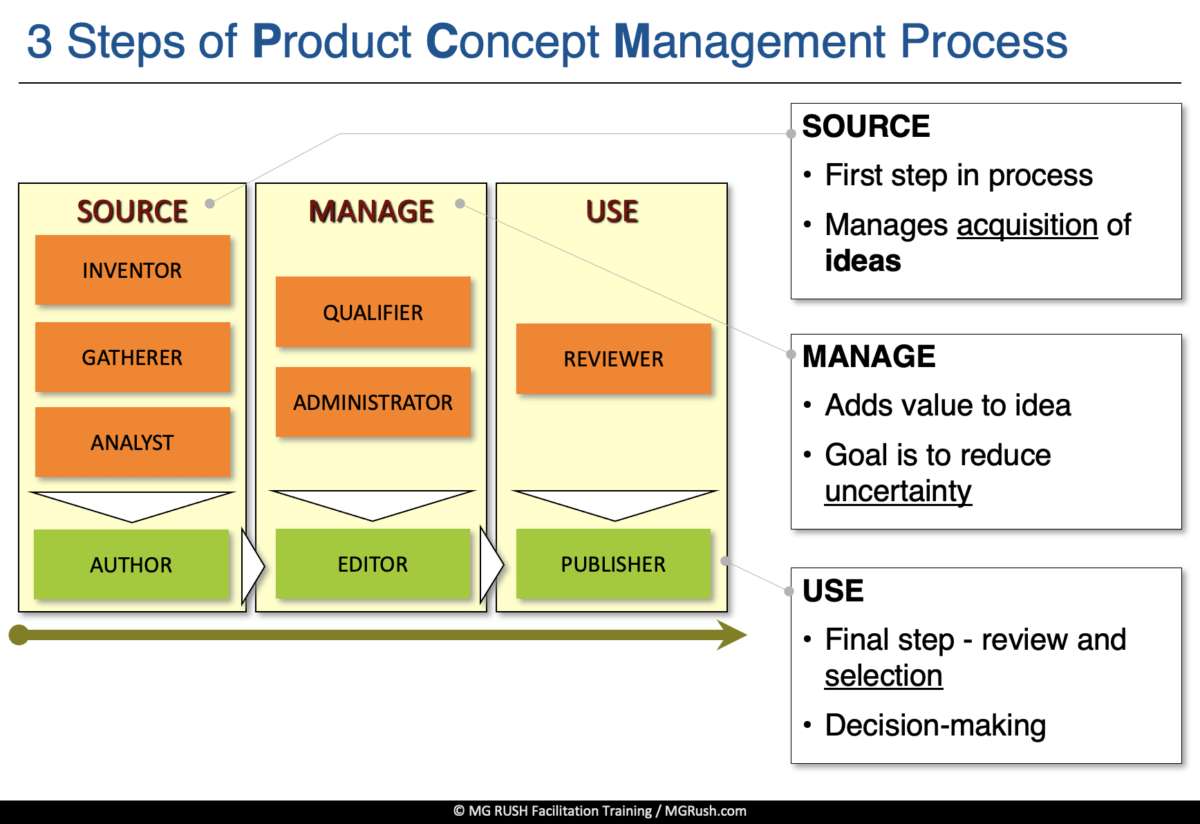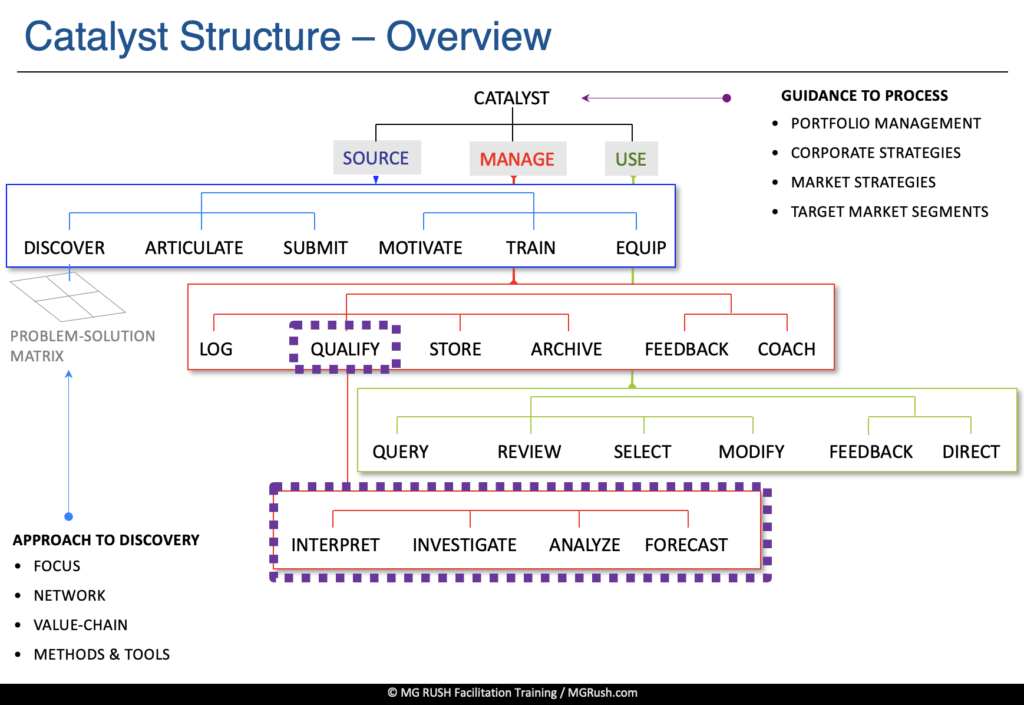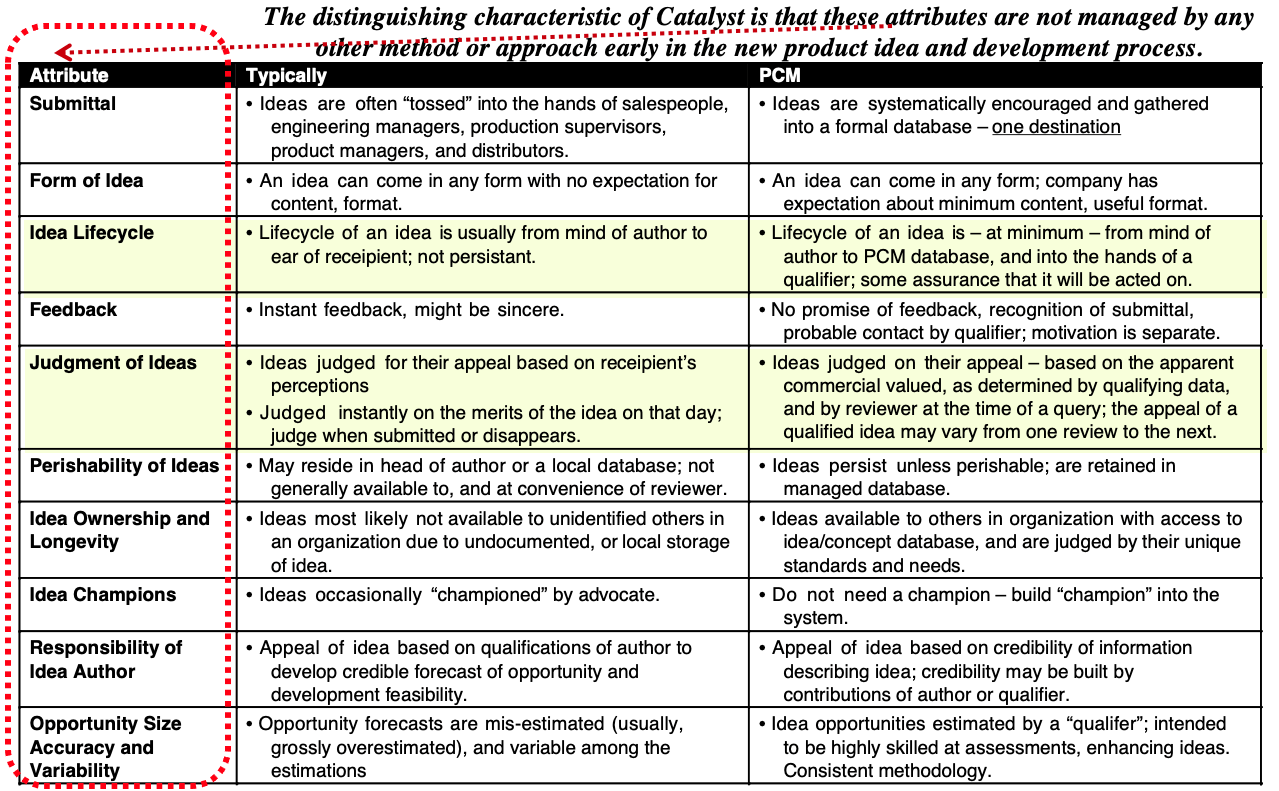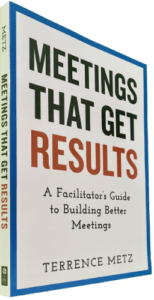Our last article launched a method for managing new product ideas called Catalyst or PCM
Now we take a step back before explaining the activities (next article) to tackle some of the myths and gremlins associated with new product concept management and development.
New Product Concept Development Disciplines
Product Concept Management requires numerous disciplines, including technical, information systems, creative, marketing, and financial management. Cross-functional demand frequently becomes a point of failure for many organizations in their attempts to maintain a fertile pool of new product ideas. The PCM process comprises three major steps: “SOURCING” ideas, “MANAGING” ideas (into concepts), and “USING” concepts for further evaluation and possible development.

The act of ‘deciding’ represents the most important activity of PCM; deciding whether to USE or publish a concept for further development. Without the movement of a concept onto final development, no useful work gets accomplished. At the same time, most investment today focuses on the SOURCING or authoring activity. Namely, the source volume and “creativity” of the ideas placed for consideration.
With Catalyst, the bulk of the work occurs during QUALIFYING. PCM holds that raw ideas represent slight notions of a product or business need. Most new product people have enough “good” ideas. In truth, most ideas are “good,” but suffer from a lack of certainty about their future viability.
In our view, their degree of certainty distinguishes good ideas. The QUALIFYING step in PCM requires activities that convert raw ideas into polished concepts. Then polished concepts become available for consideration and additional investment.
Product Concept Management (PCM or Catalyst) and Development Overview
PCM specifies each step as multiple, discrete activities. In practice, often compressed in time, they look like a single step. For example, when a salesperson suggests an idea to a product manager. In that discussion, the product idea takes partial form in terms of its function, customer benefits, competitive situation, and future sales opportunities. The product manager evaluates the idea for fit into the product line, corporate marketing strategy, and the organization’s appetite for funding new products. In this example, the bulk of the PCM technique occurs in a matter of minutes.
Typical Idea (Instant) Evaluation Process
The Many Product Concept Management Myths
Many myths perpetuate the practical and academic field of New Product Development and Ideation. We don’t purport to disrupt the belief system of these fields but do wish to add to the excellent progress made in recent years in improving the management of Ideation and New Product Management.
MYTH: There are good ideas and bad ideas, but only a few really great ideas.
FACT: All ideas are good as long as they are sound in their construction. An idea seen by a business manager (or “reviewer” in our parlance) may be a poor fit for the business conditions of that day and for his/her specific purposes. But fit does not equivocate to the quality of an idea. PCM frees ideas from judgments of “good” or “bad.” The “goodness” of an idea depends on two characteristics of the reviewer: (1) the fit of the idea with the needs of the company, and (2) certainty about the future performance of the product in the market, in the hands of a specific company, through specific channels, to specific customers, at a specific time. These two characteristics do not depend on the idea but on the owner of the idea. The burden of finding “great” ideas, therefore, falls into the hands of the organization.
MYTH: We don’t need more ideas, we need “home runs.”
FACT: An organization and its management may want “home runs.” They seek the eventual impact of new product ideas, not whether the idea becomes a “home run” or not. A home run for one company could be a dud for another. A home run this year could be a dud next year. With slight changes in material specifications, the dud could become a cash cow in a different division. The burden is not on the idea of being great. The challenge of greatness belongs to those who handle the idea.
MYTH: We don’t have enough ideas. We’ve run out.
FACT: Zillions of new ideas develop every day. Each of us probably develops a handful of new ideas for products, product attributes, packaging, and so on. Many take shape before we arrive at our offices, based on our morning routines. Frequently we envision ideas, but perhaps not for our own business. Those ideas might be availed to whomever is willing to invest to gather them. Ideas arise in our heads continuously, for untold numbers of products and applications. Most of these ideas evaporate soon after they form.
MYTH: Our new product development process is terrific. We need better filters at the ideation stage to keep the bad ideas out. (Or, more filters are better.)
FACT: We don’t argue that your NPD process may be functioning well, or that ideas pass through development and flop in the market. However, more and better filters do not assure better product market performance. The perfect filter would be needed only once. Therefore, “more filters” implies low-quality filters at each stage of their application. More ideas indicate more success, with better information about their prospects, rather than fewer with tighter filters. If the profitability of an idea exceeds thresholds with 100% certainty when conceived, it would be pushed through development and launch with no filters. The defect in NPD and launch is not “bad” ideas or necessarily poor filters. The quality of information about the prospects for a new idea or the “certainty” of an idea’s prospects drives improved decision-making.
MYTH: We can’t afford to invest in many new product ideas.
FACT: Again, we don’t take issue with the notion of allocating scarce investment resources. However, we believe that if proper investment is not made at the earliest stages of idea management, poor-performing concepts will make it through NPD and into launch (for eventual failure) without sufficient success to pay for the failures.
MYTH: We can’t afford a product failure.
FACT: No one wants product failure, but some failures cannot be avoided. To eliminate new product failures, the only complete solution prohibits new product development. To accept a reasonable degree of risk, investment is required to reduce the uncertainty around a new idea.
MYTH: We don’t need a process of new product ideas, we need a champion.”
FACT: A “champion” provides prima facie evidence that your approach remains hostile to new product ideas and new product success. Perhaps not by intent, but by behavior. A champion is only needed when one or more of these conditions exist:
- The existing new product idea and development process has low/no credibility within the organization (or doesn’t exist) and the “champion” acts in a vacuum;
- “Certainty” appears only to the champion and not to the people involved, and the champion provides the lone supporting voice.
Popular business management lore converts folk heroes into “champions.” Champions reflect a failure to create a viable system that transcends individual fortitude and charisma. When you find an aggressive “owner” of a neutral method, then you’ve found your true “champion.”
MYTH: There isn’t enough money to support more new product ideas.
FACT: Money abounds. With a decent idea and reasonable certainty. you can attract a virtually endless supply of money. An idea with a certain payoff will attract investment with ease. Certainty provides the key. Money stays away from ideas it doubts. Venture capitalists knowingly invest in incredibly risky ideas: they invest in ideas they feel have a reasonably good chance of success after researching the opportunity. Venture capitalists accept different risks than the average corporation, but not necessarily more risk, and certainly not less well-researched ideas. The more certainty in the performance of your idea, the easier the money will be found.
Product Concept Management Gremlins
Many “gremlins” also arise in Product Concept Management. By gremlins, we mean the attitudes, behavior, policies, and cultural norms that tear at the fabric of successful new product ideation and development. Gremlins operate to hinder PCM at any time, in many ways, and with frightening effectiveness.
Gremlins range from apathy to “championing” a product through to launch. Our observation of the greatest gremlins suggests:
- Apathy – When the motivation to share new product ideas with those who can make use of them diminishes the apparent idea flow.
- Arrogance – When a participant in ideation and/or new product development demonstrates the arrogance to diminish ideas from other sources. Thus, they discourage the prolific exchange of new ideas that hamper the new idea process.
- Under Investment – The critical investment in a new idea demonstrates the assessment of its commercial, technical, and financial viability, especially early in the life of an idea.
- Lack of Direction – Do not build your PCM to be ad hoc. Catalyst requires clear direction to focus scarce resources toward the most productive sources of new product ideas that support the organization’s strategy.
Before we explain the various agendas supporting the primary steps in Catalyst, a forthcoming article provides some excellent and practical tips on “Teams and Team-Building Techniques.”
~~~~~~~~~~~~~~~~~~~~~
[1] The term “service” can be freely substituted for the tangible concept of “product.”
~~~~~~~~~~~~~~~~~~~~~
The following provides you with a Holiday Gift. Below are links to sites found in our Best Practices articles, but seldom recognized. No doubt you’ve seen a few already. However, a few of them will cause a WOW reaction:
- 20 Prioritization Techniques
- 5,620 Types of Music
- Alumni Resources and Course Materials
- Atlas Obscura
- Basic Facilitation Skills: #1 How to Facilitate Alignment using Power Balls and a Decision Matrix
- Beautiful Noises
- Business References
- Creativity Tools
- Disposable Email Address
- Facilitation Training Calendar
- Internet Archive
- Liberating Structures
- Management Models
- Meeting Design Solutions
- Mental Floss Facts
- Newseum Front Pages
- People Map of USA
- Project Gutenberg
- Radio Stations Everywhere
- Real-Time Flight Tracker
- Reference Desk
- Scrum Events Agendas
- Service Projects for Humanity
- TED’s 100 Websites
- Teleconference Call
- The Size of Everything
- Tool Visualization
- Training Games
- Walking Gorilla
______
Don’t ruin your career by hosting bad meetings. Sign up for a workshop or send this to someone who should. MGRUSH workshops focus on meeting design and practice. Each person practices tools, methods, and activities daily during the week. Therefore, while some call this immersion, we call it the road to building high-value facilitation skills.
Our workshops also provide a superb way to earn up to 40 SEUs from the Scrum Alliance, 40 CDUs from IIBA, 40 Continuous Learning Points (CLPs) based on Federal Acquisition Certification Continuous Professional Learning Requirements using Training and Education activities, 40 Professional Development Units (PDUs) from SAVE International, as well as 4.0 CEUs for other professions. (See workshop and Reference Manual descriptions for details.)
Want a free 10-minute break timer? Sign up for our once-monthly newsletter HERE and receive a free timer along with four other of our favorite facilitation tools.
Go to the Facilitation Training Store to access proven, in-house resources, including fully annotated agendas, break timers, and templates. Finally, take a few seconds to buy us a cup of coffee and please SHARE with others.
In conclusion, we dare you to embrace the will, wisdom, and activities that amplify a facilitative leader. #facilitationtraining #MEETING DESIGN

Terrence Metz, president of MG RUSH Facilitation Training, was just 22-years-old and working as a Sales Engineer at Honeywell when he recognized a widespread problem—most meetings were ineffective and poorly led, wasting both time and company resources. However, he also observed meetings that worked. What set them apart? A well-prepared leader who structured the session to ensure participants contributed meaningfully and achieved clear outcomes.
Throughout his career, Metz, who earned an MBA from Kellogg (Northwestern University) experienced and also trained in various facilitation techniques. In 2004, he purchased MG RUSH where he shifted his focus toward improving established meeting designs and building a curriculum that would teach others how to lead, facilitate, and structure meetings that drive results. His expertise in training world-class facilitators led to the 2020 publication of Meetings That Get Results: A Guide to Building Better Meetings, a comprehensive resource on effectively building consensus.
Grounded in the principle that “nobody is smarter than everybody,” the book details the why, what, and how of building consensus when making decisions, planning, and solving problems. Along with a Participant’s Guide and supplemental workshops, it supports learning from foundational awareness to professional certification.
Metz’s first book, Change or Die: A Business Process Improvement Manual, tackled the challenges of process optimization. His upcoming book, Catalyst: Facilitating Innovation, focuses on meetings and workshops that don’t simply end when time runs out but conclude with actionable next steps and clear assignments—ensuring progress beyond discussions and ideas.





